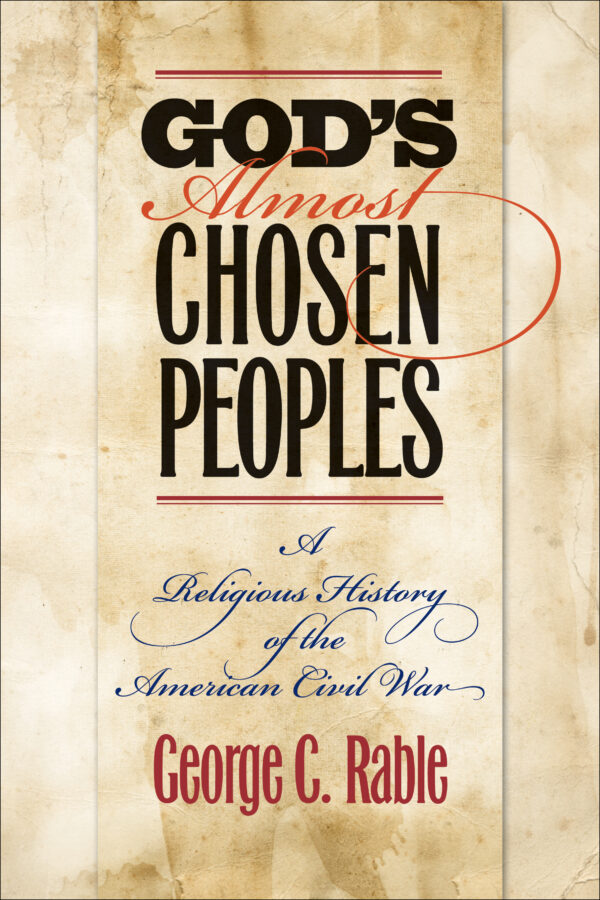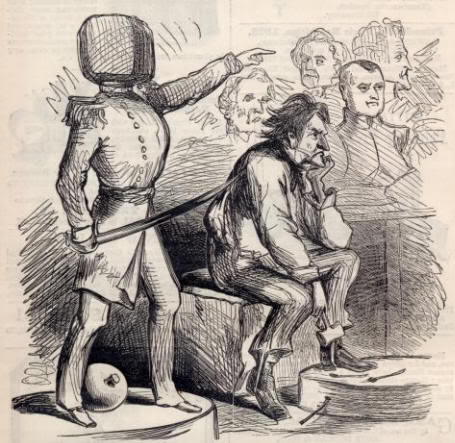God’s Almost Chosen Peoples: A Religious History of the American Civil War by George C. Rable. Chapel Hill: University of North Carolina Press, 2010. Cloth, ISBN: 0807834262. $35.00.
 “I shall be most happy indeed if I shall be an humble instrument in the hands of the Almighty, and of this, his almost chosen people,” Lincoln told an audience two months before Sumter. Invoking humility and instrumentality, God’s will and popular will, Lincoln’s speech highlights the major tensions at play in George Rable’s new book. Most importantly for Rable, Lincoln is summoning the vision of a providential promise. For those accustomed to imagining themselves as part of a redeemer nation, Lincoln’s “almost” in “almost chosen people” warned that the parable of America as a New Israel could not stand if the Union dissolved. Lincoln’s phrase is a fitting, haunting title because it articulates the hopes and anxieties of so many Americans that Rable captures in his capacious religious history of the Civil War. While he avoids making overarching claims about the effect religion had on the war and the war on religion, Rable observes that Americans north and south, black and white, saw the war in providential terms, and that this tendency had remarkable resilience throughout the conflict.
“I shall be most happy indeed if I shall be an humble instrument in the hands of the Almighty, and of this, his almost chosen people,” Lincoln told an audience two months before Sumter. Invoking humility and instrumentality, God’s will and popular will, Lincoln’s speech highlights the major tensions at play in George Rable’s new book. Most importantly for Rable, Lincoln is summoning the vision of a providential promise. For those accustomed to imagining themselves as part of a redeemer nation, Lincoln’s “almost” in “almost chosen people” warned that the parable of America as a New Israel could not stand if the Union dissolved. Lincoln’s phrase is a fitting, haunting title because it articulates the hopes and anxieties of so many Americans that Rable captures in his capacious religious history of the Civil War. While he avoids making overarching claims about the effect religion had on the war and the war on religion, Rable observes that Americans north and south, black and white, saw the war in providential terms, and that this tendency had remarkable resilience throughout the conflict.
Appeals to providence could be at once salve and salvo—a recognition of the limits of human control over their environment, or a certitude in God’s favor that made compromise impossible. The author makes a notable contribution by capturing this ambiguity and malleability of religion, and he does it with impressive research and accessible prose. He succeeds in restoring historical actors’ supernatural understandings to a Civil War literature that has marginalized them. Still, this work does not so much break new interpretive ground as it collects a myriad array of religious voices. The book is synthetic not analytical, descriptive not argumentative. While it achieves an unmatched inclusivity, rather than being “the only comprehensive religious history of the war” as the publisher describes, Rable’s book may be more helpfully seen as he describes, as a religious history, not the religious history. As American religious history’s stock has been rising in recent years, scholars like Harry S. Stout and Mark Noll have made significant inroads into Civil War history, although the Civil War master narrative has yet to integrate religious concerns. Diverging from Stout’s provocative analysis of civil religion, Rable opted to tell a broad narrative rather than a “thesis-driven” story (6). In so doing, he makes it hard to assess what the significance of providential thinking actually is. Allusions to God’s will were more pervasive than profound, he notes. As he locates providential views as more an inheritance of Puritan Calvinism than Second Great Awakening revivalism, the implication of providential appeals in an increasingly modern age begs for more analysis. Nonetheless, as a bridge between the Shelby Foote Civil War reader and the scholarly debates of religious history, as a wedge that opens the door to a new set of questions and concerns for Civil War history, this book is a welcome intervention.
As Rable’s twenty chapters unfold, moving thematically and chronologically, he illuminates religion’s capacities and does not sugarcoat religion’s failures. On the eve of war, the nation is in spiritual crisis. Anxieties over religion’s proper role in public life make most preachers tepid and others rabid sectionalists intensifying the impasse. The “pious were part of the problem,” perpetuating either a dangerous fatalism or an irresponsible righteousness (50). During the war, chaplains on both sides were always in short supply and were more often “‘a curse rather than a blessing,’” as armies burdened them with responsibility but gave them no authority or support (112). Churches that imagined the army as a vast home mission field saw more gambling and venereal disease than conversions. Still, soldiers appreciated the Bibles widely distributed throughout the camps by philanthropic societies, and 1863 camp revivals roiled religious indifference. Christians remained a minority of the soldiery, with estimates ranging from 10-25% for the Union and 30% in the Confederacy, but Christianity nevertheless came to be seen as an enduring part of soldier identity, especially among Confederates. Church membership and attendance on the home front steadily declined, religious schools closed their doors as their students enlisted, theological discussions and family domestic religious observance languished as the nation was preoccupied with war. Yet even as ministers preached to vacant pews, political leaders regularly came to call for national prayer and fast days. As providential thinking became fused with hopes for the state, the church by all traditional measures suffered. But Rable resists claims that the war weakened religious faith, refusing to see religion as merely the sum of its parts. What is remarkable, he contends, is that despite underwhelming institutional numbers and evidence of traditional religious practice, people maintained an adherence to providential thinking. As the war drew to a close, and people sought to interpret the purpose of it all, religious explanations gained new valence for this “holiest” war in American history (397).
Rable’s source base ranges from the published work of sermons and synods and religious presses to the private writings of ordinary folks, and he makes room for non-Protestant groups such as Catholics, Mormons, and Jews. One particular “group,” however, deserves a more prominent role. While Rable does an admirable job of including black institutional churches, he incorporates little from slaves or their “invisible institution.” Slave religion—with its use of conjure, its intimacy with God, its infusion of secular and sacred, its rejection of Calvinist assumptions that providence was predetermined—was creative and transformative in ways that differ from the providential worldview Rable tends to focus on. If the parable of the New Israel was to have any credence for slaves, it could only be possible when America ceased to be Egypt. If emancipation came to be central to providential understandings of the war, as Rable explores, then the religious forces behind emancipation deserve further scrutiny, and the beliefs of four million slaves surely had something to do with it.
With its prodigious bibliography and its mandate to address the proliferation of faith in the primary sources, God’s Almost Chosen Peoples will be a resource for and an invitation to students of both religion and the Civil War. When it comes to recovering that most ephemeral of historical artifacts—belief—Rable has acted, he might say, as a humble instrument in service of a people he can seem to know—almost.
Abigail Cooper (M.A.R., Yale Divinity School) is a Ph.D. Candidate in History at the University of Pennsylvania.
